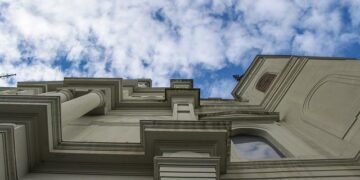This article was produced by National Geographic Traveller (UK).
Pinned by the Eiffel Tower, threaded by the Seine and punctuated by grand gardens that are multiplying as part of the city’s bid to become one of Europe’s greenest, Paris is among the world’s most impressive destinations. Here are 17 ways to discover the City of Lights this summer.
1. Go electric on a classic city tour
Battery-powered cars have become an increasingly popular sight in Paris over the last decade – all part of the city’s plan to outlaw all but e-vehicles by 2030. In a vintage Renault 4L, retrofitted by tour company 4 Roues Sous 1 Parapluie with a specially designed battery, you can slip silently between the honey-coloured apartments and cast iron balconies of the eighth arrondissement, the vast alabaster arch of the Arc de Triomphe and the broad, latticed feet of the Eiffel Tower, close enough to see the cogs rotating. This year, it will have been 100 years since Paris last hosted the Olympics in 1924, and the tower is being repainted gold – closer to the colour Gustave Eiffel originally chose – to mark the occasion.


Off Paris Seine is one of few ways travellers can live on the water in the city.
Photograph by Ludivine Le Cornec (Top) (Left) and Photograph by Nicolas Anetson (Bottom) (Right)
(Paris is going electric — for a new perspective on the city, take a low-carbon car tour.)
2. Hop around the Paris Plages
July to September, Paris embraces beach mode, carving out waterfront stretches of its emblematic river and canals for temporary urban beaches – complete with deckchairs, potted palm trees, ice-cream sellers and entertainment. At Hôtel de Ville (City Hall), quays along the Seine between Pont d’Arcole and Pont Neuf buzz with outdoor, family-friendly action such as a mini via ferrata, football, giant chess, plus sun-loungers between potted palm trees and pétanque. Across the water on the left bank, soak up urban beach life on the stretch of ‘beach’ between Pont d’Alma and Pont de la Concorde. The Paris Plages’ prime swimming hub is Bassin de la Villette – until 2025, when three open-water swimming spots will open for summers in the Seine: at Bras Marie beneath Pont Marie (4e), by the Passerelle Simone de Beauvoir footbridge in Bercy (12e), and at Port de Grenelle (15e).
3. Sleep in a floating hotel on the Seine
Moored at the foot of the Gare d’Austerlitz in central Paris, bobbing gently in the wake of each passing barge, Off Paris Seine offers one of the very few ways in the city to live the life aquatic. Lying low on the surface of the water — low enough for the river’s waves to wash against the walls — the 58 floating rooms here face the city or the Seine, taking inspiration from the natural setting with plenty of warm woods, and accenting them with bright pops of gold and neon orange. The latter takes a maximalist turn in the designer Sunset suite, where everything, from the four-poster bed to the bathtub, is the same vibrant tangerine hue. Come the evening, enjoy a plate of roast octopus with pepper cream beside the pool on the sheltered restaurant terrace, close enough to the water to see shoals of tiny fish rippling across the surface, and watch the tales of the riverbank unfold. From €230 (£197) for a quay-view double, B&B.

No licence is needed to take in the beauty of the city from an electric boat.
Photograph by Marin d’eau Douche
4. Sail the waterways in an e-boat
Life moves slowly on the banks of the Bassin de la Villette. The largest artificial lake in Paris — a former industrial port 20 minutes’ walk northeast of the Gare de l’Est — is a place where cormorants bob atop yellow buoys and pet dogs trot in the shade of tall trees. Parisians come here to practice their pétanque and picnic on crusty baguette, legs dangling over the edge of the water. One of the best ways to take it all in is out on the water in an electric boat. From Marin D’Eau Douce’s marina on its southern end, you can journey north at barely walking pace, your soundtrack the lapping of the waves, the distant clinking of glasses and the tinny music of the carousel that sometimes appears on its banks. You’ll know when you’ve reached the Parc de la Villette, with its metallic orb-shaped cinema, and the Canal de L’Ourcq, the banks of which form an al fresco gallery for street artists. Three hours’ e-boat rental for five from €110 (£94); no licence required.
5. Claim a deckchair at the Molitor, birthplace of the bikini
It’s late summer and the sun is filtering through the clouds, spotlighting the bathers snoozing in their deckchairs in fluffy, white bathrobes, as swimmers paddle languidly back and forth.The frenetic pace of the city slows in the 16th arrondissement beside the pool of the Molitor, sheltered from the street on all sides by its tall, canary-yellow walls. When it opened in 1929, it was much as it is now: a place where Parisians could escape and sip glasses of Chablis between the palms — part urban oasis, part social club.
All sorts of events, from artists’ galas to beauty contests, were held here. At one time, a tobacconist and even a hair salon fringed its borders. It was known for being an avant-garde place. Perhaps most famously, French designer Louis Réard unveiled the first bikini here in 1946. His design was considered so scandalous that no model would wear it, so he had to turn to an exotic dancer for its poolside debut.

When it opened in 1929, the Molitor was a place where Parisians could escape and sip glasses of Chablis between the palms — now it sits within a hotel.
Photograph by Sebastien Giraud, Alamy
But by the 1970s, cracks began to show — literally, with chlorine eroding the concrete. The pool closed in 1989, no longer able to fund its vision of extravagant lifestyle, and graffiti artists washed in as its waters drained away. For years, the Molitor lay derelict — a landmark transformed into a backdrop for underground raves. But its story didn’t end there.
By 2014, it was restored and reopened its doors as a hotel. Those same artists that had instilled beauty into its earlier neglect were invited back, this time to add the finishing touches to the lobby — where a graffiti-splashed Rolls-Royce now sits — and wall murals.
There are 124 rooms, designed to emulate the feel of an ocean liner; portholes overlook the watery scene below, with the swimmers, snoozers and croque monsieur-ers. After the piscine was rebuilt, it made its Hollywood debut in The Life of Pi. And with bikinis back at the Molitor, the Parisians flooded back, too. Doubles from €330 (£283), B&B. Day pass, including room access, from €290 (£248) for two.
6. Cool off in an al fresco pool
Piscine Joséphine Baker
Swim on the river — rather than in it — at this pool, named after the legendary Jazz Age performer. It’s set on a permanently moored barge, floating on the Seine in the 13th arrondissement not far from the Bastille. The glass roof retracts in good weather, allowing for sunbathing on deck. Alongside the main pool, there’s a paddling pool for children, as well as solariums, saunas, a gym and changing rooms.
Piscine Roger le Gall
To the east of the capital, in the 12th arrondissement, the 164ft Roger Le Gall pool is part of a sports complex, with a retractable roof so that swimming becomes al fresco on sunny summer days. It’s named after a French resistance fighter, and has rolling lawns for sunbathing and dedicated sessions each month for naturists.
Piscine de la Butte-aux-Cailles
One of Paris’s rare listed pool complexes, Butte-aux-Cailles in the southern 13th arrondissement opened its doors in 1924. The main indoor pool still has its art deco arches, while there are also two outdoor ones. They’re all open year-round, kept warm at a toasty 28C thanks to the complex’s natural sulphur spring.


Tour guide Ana Gimena takes visitors on a historical excursion of the city, concluding in the garden of the Petit Palais.
Photograph by Amelia Duggan (Top) (Left) and Photograph by Ludovic Balay, Getty Images (Bottom) (Right)
7. Discover Paris’s belle epoque on foot
It’s easy to slip back in time in Paris; pockets of the gilded belle epoque have been preserved throughout the city centre, casting a spell on most who walk the capital’s streets. This golden age of bohemia, optimism and technological progress flourished in the peaceful years between 1871 and the start of the Second World War. To find its legacy, you need only pay a visit to restaurants like Bouillon Chartier, a timewarp ‘workers’ bistro built with breathtaking flamboyance in 1896, where tables are shared and uniformed waiters still tally the bill on the tablecloth. The Grand Palais, Alexandre III Bridge, Musée d’Orsay and Galeries Lafayette are products of this period, too.
Many walking tours cater for those wanting to immerse themselves in the era; family-friendly guide Ana Gimena dresses for the era on her tours around the galleries of the Petit Palais and the esplanades around the Seine. Or try the ‘Visit Montmartre with Hysterical Feminists’ tour by Feminists in the City to learn the stories of embattled and half-forgotten female figures from the gilded period.
(Does Paris’s belle époque appeal live up to the hype?)
8. Learn to paint like an Impressionist
Celebrate the 150th anniversary of Impressionism in the city where it all began. Monet, Cézanne, Bonnard and many more ventured to the French capital to find inspiration in its skies and landscapes. A stroll along the Seine, along with a visit to the Gardens of Versailles, Tuileries Garden and Luxembourg Gardens will provide great backgrounds for a painting session with Rola Cusson, a tour guide and art teacher with a studio on La Grande Jatte — the setting of Seurat’s 1884 painting A Sunday on La Grande Jatte. For contemporary art, 59 Rivoli is a former artists’ squat-turned-gallery and exhibition space that hosts free concerts every Saturday and Sunday.

For a non-touristy Paris morning, stroll along the Seine’s Left Bank and take in the half-mile outdoor gallery.
Photograph by Jonathan Stokes
9. Take a street-art treasure hunt
Tracking down mosaics by Paris’s anonymous street artist, Invader, means ducking and diving around streets, squares and courtyards off travellers’ usual radar. To add to the 23 million ‘flashes’ validated since 2014, download the FlashInvaders app and snap each pixelated piece you find: space aliens inspired by the 1978 arcade game, but also pop culture figures such as Bugs Bunny, Cinderella, Mario, Picasso, Nina Simone. Score 100 points apiece with Paris’s highest (on the Eiffel Tower), biggest (at Place Igor Stravinsky) and most recent (Invader’s 1500th Parisian mosaic, atop a blue rooftop pipe at Centre Pompidou), which was erected in February 2024.
10. Spot sculptures by the Seine
Stroll along the Seine’s Left Bank, between the Pont de Sully and Pont d’Austerlitz bridges, and you’ll encounter an outdoor gallery stretching for almost half a mile along the waterfront. Opened in 1980, within the Jardin Tino Rossi, the Musée de la Sculpture en Plein Air is still in immaculate shape, displaying remarkably graffiti-free works by 20th-century artists including César, Constantin Brancusi, Nicolas Schöffer and Émile Gilioli. Some pieces are set proudly along the quayside, like oversized mooring posts, while others are weathering gently among the prettily planted gardens patchworked along the riverside, bothered only by the occasional jogger, dog walker and pedestrian commuter, plus a rare tourist or two.
Standout pieces include Demeurre 1, a bold, blackened bronze gathering of totemic structures created by Etienne Martin in the 1950s, and La Grande Fenetre, by Cuban artist Augustin Cardenas. The latter creates a gleaming white marble waterfront ‘window’ through which to watch the open-roof bateaux mouche tourist boats chug by. On weekend evenings during the summer months, the sculptures become a backdrop for couples practising tango in the small amphitheatres carved into the Quai Saint-Bernard promenade.

New bike lanes in the city means getting around on two wheels might just rival the Nordics.
Photograph by Jonathan Stokes
11. Embrace two-wheeled Paris
With just over 250 miles of cycleways, including 75 miles of brand new lanes, linking the Eiffel Tower, Place de la Concorde and other soon-to-be Olympic venues, exploring Paris by bike has never been so easy. Dedicated bike tracks link up with shared bike-bus lanes and car-free trails for use by both cyclists and pedestrians. The best routes include a loop along the Seine, taking in landmarks like the Louvre and Notre-Dame; a spin along Canal St-Martin, passing 19th-century locks and lift bridges; and an exhilarating urban route along ‘Street Art Avenue’ to France’s national stadium in Saint-Denis.
12. Party with the Pari Rollers
The Friday Night Fever skate tour organised by the Pari Rollers association is one of the largest meetups of its kind in the world, offering rollerbladers a fun and fast-paced tour of the capital after dark. The weekly, 13-mile urban skate kicks off at Place Raoul Dautry, regularly attracting upwards of 800 participants, and is geared towards confident skaters rather than first-timers. The atmosphere is like a carnival: as well as impressive feats of skating by seasoned pros, there’s music blaring from portable speakers, participants in fancy dress and even parents in the mix with off-road prams. Those who aren’t confident with rollerblading can join the cyclists, e-scooters and longboarders bringing up the rear of the procession – or simply come to watch participants career along the Parisian streets.
(What it’s like to party in the French capital with the Pari Rollers.)
13. Stroll reimagined city railways
The original High Line isn’t in New York – it’s in Paris. The Coulée Verte René-Dumont, or Promenade Plantée as it’s become known, was the world’s first elevated urban park when it opened in the late 1980s, transforming a disused railway viaduct into a linear garden of swaying trees, starlings and reflecting pools. Paris is planning to – quite literally – become one of Europe’s greenest capitals, with current mayor Anne Hidalgo promising a “massive greening” when she was elected, and the plan to plant 170,000 trees by 2026 underway. Simultaneously, attention has turned to La Petite Ceinture, another train line that was abandoned in the 20th century and still circles the city, with some very short stretches open to urban hikers. Parisians are divided on what to do with this ghost line, with some calling to preserve its biodiversity and open up the entire stretch to pedestrians – though most of its length is still closed, in part due to still-active electrical lines. For now, while the authorities decide, the ‘Little Belt’ runs in a broken circle, some of it used for flourishing community gardens and craft fairs, and the rest left to be reclaimed by nature.
(The ‘original’ High Line is in Paris — here’s why you should walk it.)


Paris’ current mayor Anne Hidalgo made big promises of a “massive greening” if she was elected. Now the city hopes to be one of Europe’s greenest capitals.
Photograph by Jonathan Stokes (Top) (Left) and Photograph by Jonathan Stokes (Bottom) (Right)
14. Climb Lafayette’s summer terrace
The eighth-floor terrace of Paris’s most venerable department store is where the capital’s beautiful young things come to pose with cocktails in summer, backed by Galeries Lafayette’s landmark cathedral-like glass dome. Among the sweeping city views, there are other knockouts, too: the Eiffel Tower, Sacré-Coeur and Notre-Dame can all be seen from up here. The terrace’s pop-up restaurant usually opens for the season around May and runs until the end of September. In previous years, it’s been hosted by socialite French chef Julien Sebbag, whose vegetarian small plates menu celebrates eastern-Med salads and focaccias such as the courgette-starring Summertime Sadness — best paired with a spritz of prosecco, orange blossom, cognac and apricot liqueur.
15. Drink farm-fresh cocktails
Tuck into summer’s bounty of berries, beets and all other manner of fruits and veggies, freshly harvested from Europe’s largest urban rooftop farm, at Le Perchoir (‘The Perch’) — a plant-filled conservatory dining spot crowning Pavilion 6 of the exhibition centre Paris Expo Porte de Versailles. The restaurant overlooks Nature Urbaine, a high-tech farm that provides fresh produce to the surrounding 15th arrondissement and some nearby hotels. Produce is grown using aeroponics — a soil-free cultivation technique that can minimise irrigation — creating an edible Eden in a sky-scraping urban space. What’s grown here enriches the menus at Le Perchoir, which is a hot ticket for DJ-led weekend brunches and cocktail-infused evenings. Order la haut (‘the top’) with gin, citrus shrub, rosemary, Peychaud’s bitters and house tonic, alongside a summer vegetable vol au vent, and breathe in the heady scent of rooftop-grown herbs.

Galeries Lafayette is as much a Parisian landmark as the Arc De Triomphe, with the added experience of rooftop cocktails.
Photograph by Jonathan Stokes
16. Explore urban wine in Montmartre
Once home to Dali, Degas and Van Gough, Paris’s bohemian hilltop Montmartre neighbourhood is also the site of the French capital’s oldest vineyard. Wine production dwindled in the Île-de-France after industrialisation in the 19th century and by the 1950s, Paris was all but shunned by viticulturalists. Today, however, the area’s vines are seeing a resurgence. Free from additives, Montmartre’s grapes are harvested to great fanfare every October during the Fete du Vendanges, and are just one of a booming number of low-intervention wines now being made across the Île-de-France. A walking tour of Montmartre with Paris Wine Walks can take vinophiles on a historical romp through the cobbled backstreets around the Sacre Coeur, with a finale tasting session of wines from independent vineyards in Paris and beyond.
(Winemaking in Paris is back, and you can discover its history in Montmartre.)
17. Eat in the Eiffel Tower
Book a meal at two-Michelin-starred Le Jules Verne, helmed by French chef Frédéric Anton. The second-floor salon sits 410ft above ground, with five- and seven-course tasting menus that include indulgences like souffle of scallops with shellfish butter sauce, caviar and caramelised calf sweetbread.
Bite into the ‘Jardin sur la Seine’ macaron, a raspberry confection laced with single-origin Millot Plantation Madagascar dark chocolate. It’s an exclusive creation for Paris’s Iron Lady, by chocolatier-patissiere Pierre Hermé, available at the second floor’s lower-level macaron bar.
Celebrate Paris’s seasonal produce, plucked from farms and kitchen gardens around the French capital, with chef Thierry Marx’s informal menus at Madame Brasserie, on the tower’s first floor.
Have a chocolate ice cream, cocktail and more in the open-air Ferrié Pavilion terrace on the first floor. Garden seating-style armchairs and sofas create a relaxed space with breezy views across the capital and classic French bistro food.
Get a glass of finest French fizz almost 1,000ft above Paris’s streets in the tower’s little Champagne Bar. It’s a bijou dispensary rather than a place to sit; the tipples can be paired with caviar if desired.
Getting there & around:
Eurostar operates 17 trains a day from London St Pancras International to Paris Gare Du Nord, with one-way fares starting from £39. The average journey time is two hours.
From elsewhere in the UK, there are dozens of flights per week to the French capital, including from Edinburgh, Manchester, Birmingham and Bristol.
To ride Paris’s Metro, pick up a contactless Navigo travel card from a RATP sales office or other approved retailer, which offers daily or weekly passes for two travel zones, from €8.65 (£7.40). Alternatively, the Paris Visite Ticket, which covers zones one to three/one to five, costs from €13.95 (£12)/€29.25 (£25) per day for unlimited travel.
To use Paris’s increasing number of cycle lanes to get from A to B, hire a bike from the city’s Velib bike-sharing stations.
When to go:
Annual temperatures peak in July and August, with daytime highs of around 25C; the city can empty out during August, when locals tend to take summer holidays. Travel in spring or autumn for fewer crowds.
Published in the June 2024 issue of National Geographic Traveller (UK).
To subscribe to National Geographic Traveller (UK) magazine click here. (Available in select countries only).
>>> Read full article>>>
Copyright for syndicated content belongs to the linked Source : National Geographic – https://www.nationalgeographic.com/travel/article/explore-paris-summer-beyond-olympics






























